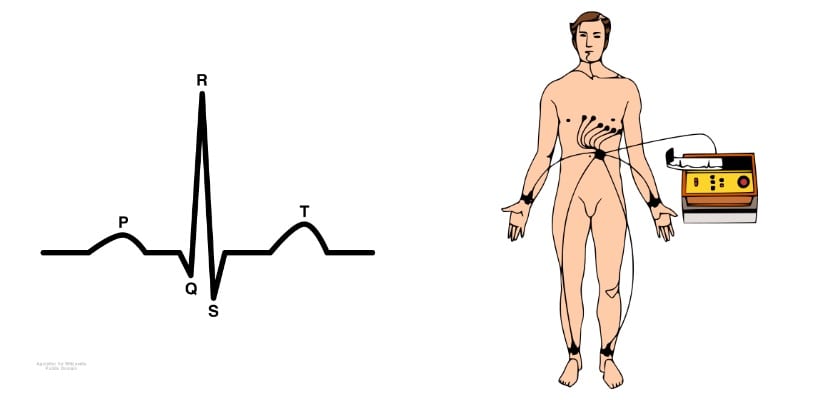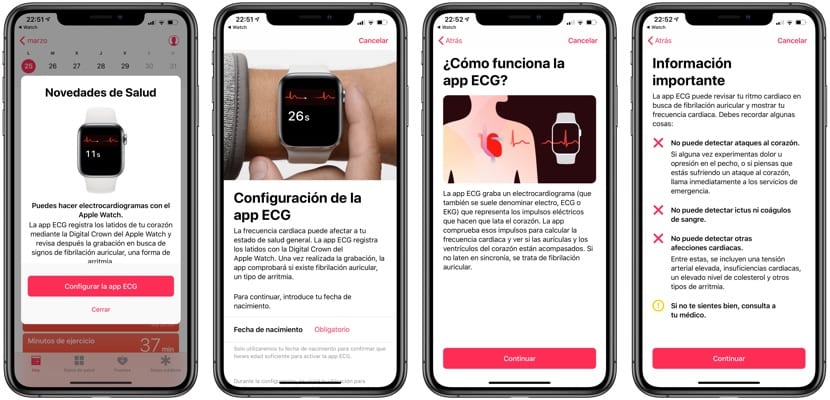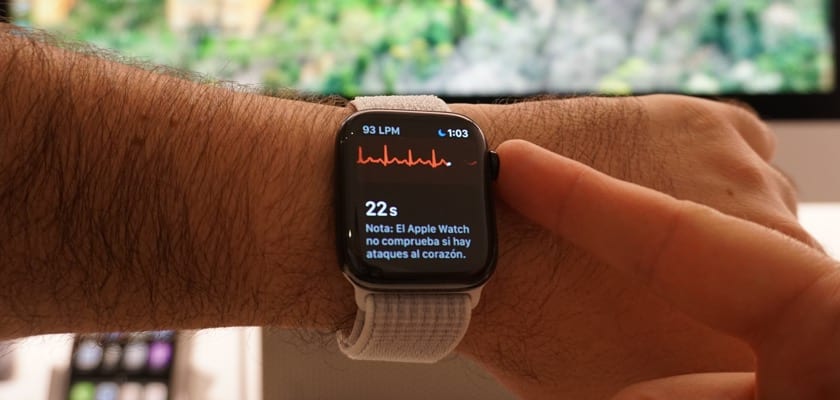As we announced a couple of days ago, Apple was about to activate the ECG function of the Apple Watch Series 4 in Spain and other European countries. The wait is over and the star function of the presentation of the Apple Watch Series 4 is now available in Spain, a good handful of European countries, in addition to Hong Kong and of course the United States where it was already active.
What is the ECG of the Apple Watch? How active? What is it for? We are going to clarify all this for you below so that you can know in depth one of the most interesting functions of the Apple Watch and which we have been talking about for a long time.
What is an ECG?
The Electrocardiogram (ECG) is a record of the electrical activity of the heart. Each beat of our heart is controlled by electrical impulses that decide when it contracts and which parts should do it. It is essential for proper operation and therefore having a normal ECG is essential for our heart to function well. To do a complete ECG, you need a device the size of a laptop and several electrodes that are placed throughout the body in order to record electrical activity and create an ECG line that is interpreted by doctors.

In the image you can see a normal ECG with the different waves that make it up. We are going to pay special attention to the first wave, the P wave because it is where the Apple Watch focuses its ECG function. It is one of the most important waves of the ECG, and it is abnormal in one of the most frequent pathologies of the heart rhythm: atrial fibrillation. This is precisely the arrhythmia that, as we will see later, the Apple Watch Series 4 is capable of detecting quite accurately. Why can't it detect other pathologies? Because the ECG that the Apple Watch performs is not as complete as a clinical ECG, which a doctor can do in any consultation, since it does not have so many electrodes that can collect all the electrical information.
How do I activate the ECG on the Apple Watch?
The first thing is that you must have the iPhone and the Apple Watch in the latest versions available, which at the moment are iOS 12.2 and watchOS 5.2. You must also have an Apple Watch Series 4, it does not matter if it is 40 or 44mm, Sport or steel, they all have this ability. You must also be in one of the countries where this function is available: Spain, USA, Austria, Belgium, Denmark, Finland, France, Germany, Greece, Guam, Hong Kong, Hungary, Ireland, Italy, Luxembourg, Holland, Norway, Portugal , Puerto Rico, Romania, Sweden, Switzerland, the United Kingdom and the Virgin Islands.

Once that is done, you must enter the Watch application and within the Heart app settings, where you can activate the ECG. To do this, it only asks you to enter your date of birth and read some information that you should know about the operation of the ECG application and what the Apple Watch can and cannot do., in addition to an interpretation of the results that it can offer you. From this moment on, you will have the ECG function available as one more application on the screen of your Apple Watch for you to use when you deem appropriate.
What does the ECG app do?
As we said before, the ECG application records the electrical activity of the heart, with many limitations compared to a medical ECG, it is true, but can offer very important information that can help diagnose hidden pathologies, or to better control already diagnosed patients. The results it can offer us are:
- Sinus rhythm: it is the normal rhythm of the heart, which it must have for everything to work properly.
- Atrial fibrillation: it is not normal, it is an arrhythmia (one of the most frequent) in which the P waves do not exist, because the heartbeat is irregular.
- High or low heart rate: it is simply that the heart beats faster or slower than normal. Above 120 beats per minute or below 50 beats per minute, the accuracy of the Apple Watch ECG is not sufficient to make a proper diagnosis and therefore the results are not conclusive.
- Inconclusive: The measurement is not correct, because you have moved, because the Apple Watch is not properly adjusted, etc.
What does the ECG app NOT do?
I insist again, the ECG of the Apple Watch it can never be a substitute for a medical ECG, so there are things you can't do:
- It cannot detect heart attacks (heart attack or angina). If you think you may be having a heart attack, don't waste time using your Apple Watch because it is completely useless, and call emergency services.
- Cannot detect strokes or thrombosis in other locations
- It cannot detect other conditions such as hypertension (high blood pressure), heart failure or any other arrhythmia other than atrial fibrillation.
- It is not a substitute for the opinion of a medical professional. You can offer additional information that can be very helpful, but never substitute for medical judgment.

How does the Apple Watch ECG work?
Once activated the function is very easy to use. Open the ECG application on the Apple Watch (white icon with a red ECG) and follow the instructions indicated. It is important that the watch is well adjusted, without being excessively tight, and that we are seated and calm. If possible, we have been sitting for a while so that our hearts are at rest. We place our finger on the crown of the watch and leave it there for 30 seconds which is the time it takes to perform the ECG recording. Once finished, it will indicate the result (sinus rhythm, atrial fibrillation, high or low heart rate, not conclusive).
These results can be stored in our Health application or even send them as PDF files to our doctor via instant messaging, AirDrop or email. It is a very useful tool if you know what it can and cannot do, and that in real life it has already helped several people to detect that they had atrial fibrillation that they were completely unaware of.
What are Irregular Pace Notifications?
In addition to the ECG, watchOS 5.2 activates another feature that was also not available, irregular rhythm notifications. These work from the Apple Watch Series 1 and let's say they are a more rudimentary system than the ECG of the Series 4, but it can also help detect arrhythmias that may be due to atrial fibrillation. If Apple Watch detects that your heart is beating irregularly in several independent measurements, it will send you a notification to alert you to this. This system is automatic, hence its usefulness, because remember that the ECG must be performed by the user, it is not performed automatically.
Very good article and perfectly explained, thank you.
All the best